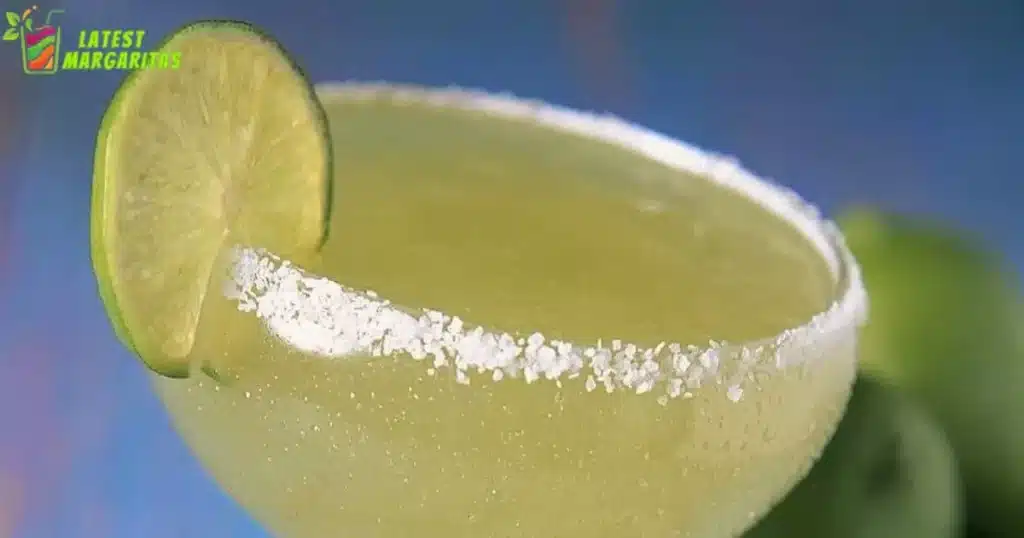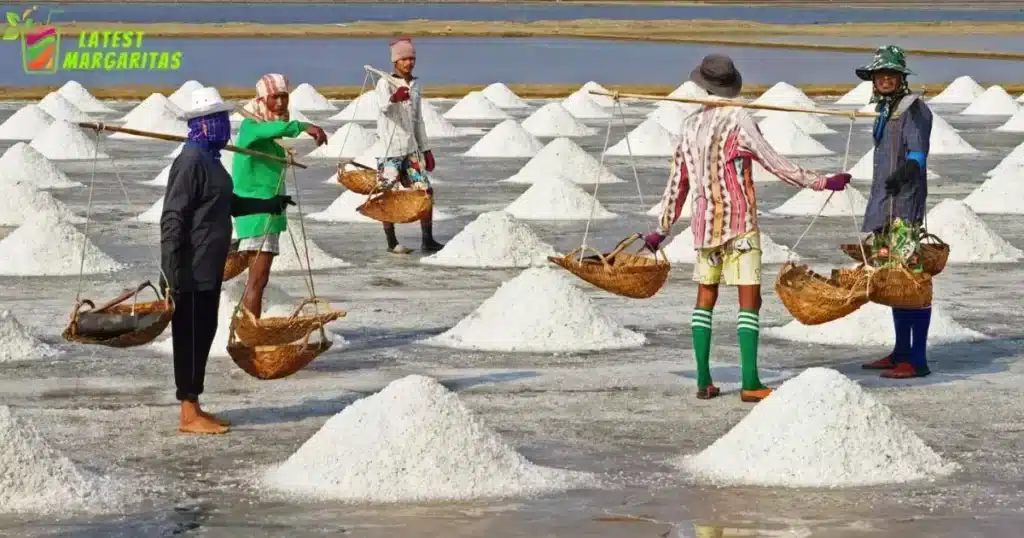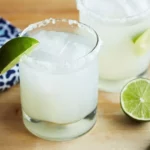Margarita salt and sea salt are both types of salt, but they have different characteristics and uses. Margarita salt is often coarser and can be flavored or colored, specifically designed for the rim of a margarita glass. Sea salt, on the other hand, is harvested from evaporated seawater and is typically used in cooking for its mineral content and flavor.
While both can be used interchangeably in some cases, their textures and flavors differ. Margarita salt is more about presentation and ritual in cocktails, whereas sea salt is more for culinary purposes.
Margarita salt and sea salt have different histories. Sea salt has been used for centuries in cooking and preservation, valued for its natural minerals. Margarita salt, however, became popular more recently, mainly for garnishing the rims of margarita glasses in Mexican and American bars.
Definition of Margarita Salt
Margarita salt is specifically designed for use in cocktail preparation, particularly for margaritas. It is characterized by its large, coarse grains, which are ideal for adhering to the wet rim of a glass. Unlike regular table salt, Margarita salt includes additional flavorings, such as lime or chili, to enhance the taste of the cocktail.
Its texture and size make it unsuitable for general cooking purposes. Margarita salt is also known for its role in the presentation of drinks, adding a decorative and flavorful edge to the glass that enhances the drinking experience.
Definition of Sea Salt
Sea salt is derived from the evaporation of seawater, retaining many of the natural minerals found in the ocean. These minerals, including magnesium, calcium, and potassium, contribute to the distinct flavor and texture of sea salt.
Refined table salt, sea salt is minimally processed, which allows it to maintain its natural color, which can range from white to gray. The texture of sea salt can vary from fine to very coarse. Sea salt is celebrated in culinary circles for its ability to enhance the natural flavors of food, making it a favorite among chefs and home cooks alike.
Historical Origins of Both Salts
The history of sea salt is ancient, dating back to prehistoric times when it was used for preservation and seasoning food. The production of sea salt has evolved over centuries, from simple evaporation ponds to modern methods that still rely on the natural process of sun and wind.
Margarita salt, on the other hand, has a more recent history, emerging as a popular cocktail accompaniment in the 20th century, particularly in Mexican and American cultures. Its use became synonymous with the margarita cocktail, a blend of tequila, lime juice, and orange liqueur, where the salt’s coarse texture and potential for flavor enhancement complemented the drink’s flavors.
Physical Characteristics
Margarita salt and sea salt have distinct physical characteristics. Margarita salt is often coarser, with larger crystals that provide a satisfying crunch. In contrast, sea salt can vary in texture, ranging from fine to coarse, offering a broader spectrum of options for different culinary uses.
Texture Differences Between Margarita Salt and Sea Salt
The texture of margarita salt differs noticeably from that of sea salt. Margarita salt is coarse and used to rim cocktail glasses, adding a satisfying crunch to each sip. Sea salt, depending on its type, can be fine or coarse, catering to various preferences in cooking and seasoning.
Color and Appearance
In terms of color and appearance, margarita salt and sea salt also exhibit differences. Margarita salt is typically white or off-white, enhancing the visual appeal when rimming drink glasses. Sea salt, on the other hand, can come in various colors, including white, pink, or gray, depending on the minerals present in the source. This variation in color adds aesthetic diversity to dishes and presentations.
Culinary Uses
Salt is a versatile ingredient in the kitchen, enhancing flavors and adding depth to a wide range of dishes. From savory to sweet, salt plays a crucial role in balancing tastes and making food more delicious.
Traditional use of Margarita Salt in Beverages

Margarita salt has a specific role in the world of beverages, especially in cocktails like margaritas. Its coarse texture and ability to adhere to glass rims create a salty contrast, elevating the overall drinking experience. It adds a zesty touch, enhancing the flavor profile of the cocktail, especially when checking the expiration date on Jose Cuervo Margarita Mix.
Various Culinary Applications of Sea Salt
Sea salt, derived from evaporated seawater, finds its way into numerous culinary applications. Whether it’s sprinkled on grilled vegetables, added to boiling pasta water, or used as a finishing touch on chocolate desserts, sea salt’s diverse textures and mineral-rich composition contribute to both the complexity and simplicity of various dishes. Its versatility makes it a staple in kitchens around the world.
Flavor Profile
Margarita salt has a distinct flavor profile that adds a salty kick to cocktails. It is coarser than regular table salt and often contains sea salt, enhancing the overall taste of drinks like margaritas. The coarse texture makes it perfect for rimming the glass, creating a delightful contrast to the beverage’s sweetness.
Taste Comparison Between the Two Salts
When comparing margarita salt and sea salt, the key difference lies in their textures and specific uses. Margarita salt, with its coarser grains, is designed to enhance the taste of cocktails, especially margaritas. Sea salt, while also providing a salty flavor, comes in various textures and is more versatile for general cooking.
Presence of Additional Flavors in Margarita Salt
Margarita salt often goes beyond basic saltiness by incorporating additional flavors. Some varieties may include hints of lime, chili, or other spices. These added flavors contribute to the overall sensory experience of the cocktail, complementing the sweetness and acidity of the drink with an extra layer of taste. Choosing margarita salt with infused flavors allows for a customized and unique twist to your favorite cocktails.
Production Methods
Margarita salt is crafted using various production methods to enhance its texture and flavor. Commonly, it involves sourcing high-quality sea salt and adding complementary elements like lime or chili. The goal is to create a coarse and flavorful salt suitable for rimming cocktail glasses.
How Margarita Salt is Produced
To make margarita salt, quality sea salt is the primary ingredient. This salt is often coarse in texture, providing a satisfying crunch when sipping a cocktail. Manufacturers may then infuse the salt with additional flavors, such as lime or chili, to elevate the overall drinking experience. The final product is carefully packaged for use in garnishing margarita and other cocktail glasses.
Sea Salt Harvesting Process

Sea salt is obtained through a straightforward harvesting process. Seawater is collected and allowed to evaporate, leaving behind the salt crystals. These crystals are then carefully harvested, washed, and sometimes refined to achieve the desired texture.
The natural minerals from the sea water often remain in the sea salt, contributing to its unique flavor profile. The simplicity of the harvesting process makes sea salt a versatile ingredient used in various culinary applications.
Health and Nutritional Aspects
Salt plays a crucial role in our health, but it’s important to use it wisely. Too much salt can contribute to health issues like high blood pressure. However, salt also contains essential minerals that our bodies need to function properly.
Nutritional Content Comparison
When comparing margarita salt and sea salt, there are some differences in nutritional content. Sea salt is often considered a slightly more natural option, containing minerals like magnesium and potassium. Margarita salt, designed for drink rims, may have added flavorings, but its nutritional value can vary.
Health Considerations for Each Type of Salt
Margarita salt, specifically crafted for cocktails, should be used in moderation due to its coarse texture and potential added flavors. Sea salt, generally considered a healthier option, still is consumed in controlled amounts. Paying attention to overall salt intake is essential for maintaining a balanced and healthy diet.
Conclusion
Margarita salt and sea salt may share the commonality of being salts, but they diverge in various aspects. Margarita salt, with its coarse texture and potential flavorings, is tailored for enhancing the presentation and taste of cocktails, especially margaritas. On the other hand, sea salt, harvested from evaporated seawater, is celebrated in culinary circles for its diverse textures, mineral content, and natural flavor.
Considering health and nutritional aspects, both salts should be used judiciously. Sea salt is perceived as a slightly more natural option due to its mineral content, margarita salt, designed for cocktails contain additional flavorings and should be consumed in moderation. Ultimately, mindful salt intake is crucial for maintaining a balanced and healthy diet.
So, whether rimming a cocktail glass with margarita salt or seasoning a dish with sea salt, understanding their unique characteristics and using them thoughtfully contributes to an enjoyable and health-conscious culinary experience.
FAQs
Can I use margarita salt for cooking?
Margarita salt is coarser and often flavored, so it’s best for rimming cocktail glasses. It’s not ideal for general cooking due to its texture and added flavors.
What’s the difference between table salt and margarita salt?
Margarita salt is coarse and may have added flavors for cocktails, while table salt is finer and more versatile for general cooking.
Can you use Himalayan salt for margaritas?
Yes, Himalayan salt can be used for margaritas, providing a unique flavor. Just ensure it’s finely ground if you want to rim the glass smoothly.
Meta
Discover the differences! Is Margarita Salt the same as Sea Salt? Unveil the unique characteristics and uses of these salts in our insightful comparison.





